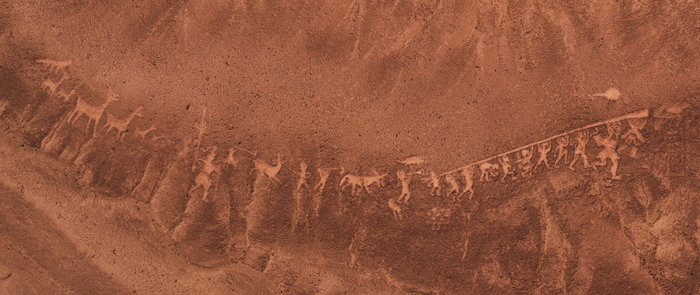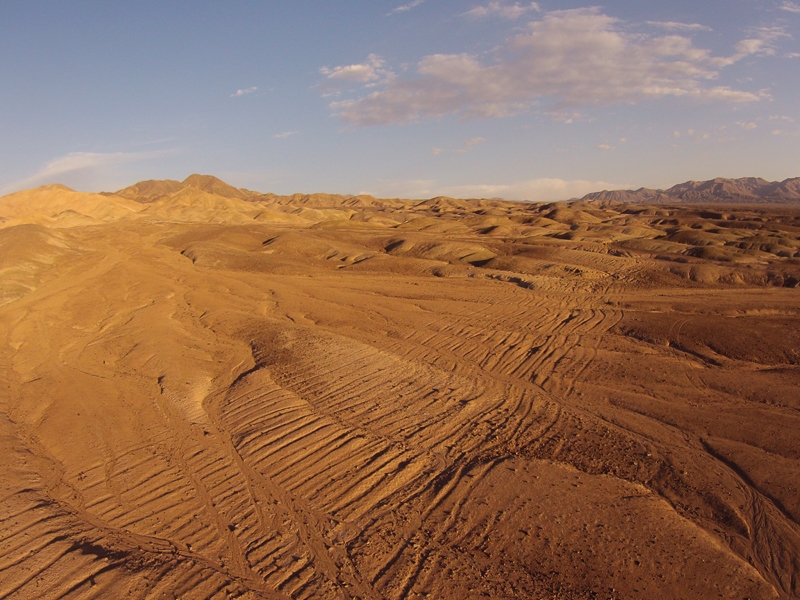In partnership with Sharjah Architectural Triennial, ArtReview publishes three new essays exploring sites of environmental struggle and models of social organisation. The essays are authored by participants in the inaugural triennial (9 November 2019 – 8 February 2020) and commissioned as part of the Rights of Future Generations: Conditions programme. The complete set of texts can be accessed on the triennial’s website and will be available as a print book from November.
And the meaning of Earth completely changes: with the legal model, one is constantly reterritorializing around a point of view, on a domain, according to a set of constant relations; but with the ambulant model, the process of deterritorialization constitutes and extends the territory itself.
– Gilles Deleuze, Félix Guattari, A Thousand Plateaus (1980)
The Atacama Desert is an ideal social laboratory, where the macro and micro effects of mega-extractive copper and lithium operations collide with the very possibility of survival for indigenous peoples – amid complex legal claims to labour, land and water.
Atacama geoglyphs are commonly found in wide, unproductive desert areas, at sites that were traditionally used only by travellers. These areas did not allow for permanent settlement during precolonial times; one can therefore state that geoglyph builders and their public were travellers themselves. On the one hand, the geoglyphs’ location was subordinate to social relations, as they unfolded to mark their entry into inhabited settlements. On the other hand, they bore witness to a context eminently determined by socio-spatial relations, as they were arranged on liminal points in the landscape, such as mountain passes.
Geoglyphs are a display of technical artistry; their endurance, power of persuasion and seduction can be explained in magical terms – that is to say, as ‘bundles of power’
Geoglyphs are characterised by their sites, which are usually of large dimensions and stand out for their monumentality, visual exaggeration and durability. Their images can be anticipated and seen from far away. Their construction implies the movement of stone and gravel, whether by subtraction or addition, so as to produce a strong contrast between the darker surface of a drawing and the lighter ground, making for a ground/figure effect. The supporting surface is thus put into motion: removed matter is never discarded, as in the case of engravings; added matter is never independent from the chosen substrate, as in the case of paintings. In this way, the removed matter always becomes incorporated material. The emphasis of one technique implies the other, if with less intensity. Some geoglyphs symbolise different habitats that travellers crossed during long journeys – habitats that were placed into relation with one another. The depiction of fauna in Atacama geoglyphs is representative of the region’s different ecological floors, from the highlands (the Suri, or Andean ostrich) through the midlands (llamas and reptiles), to the Pacific Coast (whales, orcas). Geoglyphs therefore represent both the unique agency of a travelling caravan and the geographical spaces that they brought together, from mountain to coast.
Following the work of British anthropologist Alfred Gell, one can consider geoglyphs as components of a ‘technology of enchantment’ that, in turn, results from ‘the enchantment produced by technology’. This kind of enchantment goes way beyond the scope of a beautiful or mesmerising object. The object’s effect depends on its ability to cause admiration for the technology that ‘hides’ itself.
In order to understand the technical prowess behind these works, one needs to accept that by enchanting us, the products of seemingly ‘magical’ procedures appear to encompass supernatural powers. In this sense, one of the effects of geoglyphs as art objects is that they represent themselves as surrounded by an aura of resistance, one that is the source of their value. (1) Indeed, geoglyphs are a display of technical artistry; their endurance, power of persuasion and seduction can be explained in magical terms – that is to say, as ‘bundles of power’, whose proprietary consequences we accept as if by the ‘art of magic’. Yet a geoglyph is also inherently social in ways that differ from a merely mysterious or beautiful object: it is a physical entity that mediates between one or more territorialities, creating a specific type of relationship among them. In turn, it provides a channel for social relations and new influences. Whether by cause or effect, by action or omission, geoglyphs have a ‘secondary’ polyvalent agency, which allows them to activate intense social lives. (2)

Communities of Practice and the Insistence of Justice
The Huatacondo geoglyphs, located in the municipality of Pozo Almonte (Tarapacá Region), provide an example of how precolonial art forms have survived and persevered in the Andes. They show how the communities that built geoglyphs were able to blend, tame and redeploy colonial icons and lines in their favour, by drawing pictures with stones in a uniquely autonomous and previously unimaginable way. French writer André Bellessort travelled in the region during a mining boom that was quite similar to today’s. Despite his underlying racism, he describes the Huatacondo geoglyphs’ function and content with stunning insightfulness:
‘Further on one finds true paintings that represent, in geometrical form, a checker-board or damero [Inca style], the ramps of the hills are illustrated with drawings. In them one can see llama
herds being led by Indians, staff in hand and sometimes a scared flock that seems to turn back in fright, away from the spectacle of a hanging man. The expression of fear and surprise is very well rendered.
One cannot understand how these images have been conserved through the centuries in this windy, dusty country, of camanchacas and acute weather change, neither have their hidden meanings been interpreted with any degree of certainty.
The more I think about it, the more the image of terrified beasts turning away from an executed man seems to denote in the author, a rough yet noble melancholy, a call from the heart directed to immanent justice.’ (3)
One can see lines of social tension running through the Atacama geoglyphs
Bellessort wrote in the late nineteenth century, a time when the Atacama Desert was going through its very own industrial revolution – one foddered by silver, nitrates, iodine and other resources crucial to the global economic boom and the subsequent World Wars. In South America, the revolution included the massacre of workers by the army. Human labour was harshly exploited and distributed through the gigantic railroad network that, at the time, crisscrossed these lands (though it no longer does). Bellessort’s invocation of ‘immanent justice’ reflects his own knee-jerk reaction against ‘human cruelty’ – one evident enough to make for a literary point of complaint, but not compelling enough to start a proper revolution.
Indeed, one can see these lines of social tension running through the Atacama geoglyphs: not only do they reflect spatial and temporal developments through their style, but they also tell different stories. Geoglyphs provide the foundation from which the material and intellectual history of the communities that have built them comes through as figures re-projected and reshaped, along the caravanning routes of the Atacama Desert. These same routes have helped uncountable generations to circumnavigate the Andean highlands for thousands of years.

Geoglyphs are, thus, an expression of the relational ontologies and communities of practice of Andean peoples. They are narratives that bring together historical memories and temporalities, as shown by their complex design deployed through self-effacing construction strategies (carefully chosen stones, dust, lines, ground/figure effects). They convey and combine meaning-laden travel markers in indigenous territories: settlements, water holes, oases, forks in the road, toponyms. Yet not only do geoglyphs give life to the entire desert landscape with their cosmogonic spectacle; they also tell the story of different peoples’ victories and defeats, providing a reminder of the sacredness of the entire region and its war-blessed network of lines. (4)
Communities are weaponising their newly found art, in order to confront the multinational mining giants
The sun-scorched, carefully laid out stones summon utmost admiration for Andean cosmologies and modes of existing in the world and its nature. They depict beliefs, tribes and peoples; rulers and subjects, all of whom had to struggle fiercely in order to survive in the Atacama Desert (where they are now confronting mighty giants on their own). By exhibiting universal trials of good and evil, these lines pave the way to justice for future generations, one in which different territorialities gather up to gigantic proportions. Indeed, the Atacama geoglyphs are now protected by law and cannot be altered. They cannot be copied, because of their intrinsic connection to the ground on which they were built. According to Chilean law, each geoglyph is a national monument, but the country’s citizens must effectively protect them. This is what the community of Huatacondo is doing: it weaponises its newly found art, in order to confront the multinational mining giants Teck, Anglo American and Glencore Xstrata with the hundreds of geoglyphs that have been discovered with the help of independent scientists. Now, Huatacondo has the funds to create a 100,000-hectare protected area, which means that this area could become free from mining projects in the near future. It is unclear what the government will do in response.
Territorial justice can only become a reality when governments and mining companies realise that current modes of extraction are threatening the very possibility of existence for future generations. Any possibility of justice can only be constructed through the embodied expression of memory, mapped out geo-poietically and continuously negotiated in dialogic and collective practices as well as their related ontologies. Through a participative anthropology of justice, the geoglyphs hold the potential to shed light on ways to produce and transform both memory and direct action. Hence, they can show the potential of what immanent justice entails for those who seek it, providing both a reconceptualisation of what justice delivers and the many forms, like water, that it can take.
***
1. Alfred Gell, ‘The technology of enchantment and the enchantment of technology’, in The Art of Anthropology: Essays and Diagrams (London, 1999), p. 168
2. Alfred Gell, Art and Agency: An Anthropological Theory (Oxford, 1998)
3. André Bellessort, Jeune Amérique (Paris, 1897), p. 107. Translation by the authors
4. Gonzalo Pimentel, Alonso Barros, ‘La memoria de los senderos andinos: Entre Huacas, diablos, ángeles y demoniosm’, Boletín del Museo Chileno de Arte Precolombino (2019)
***
Alonso Barros is a lawyer with two decades of experience in advocacy and anthropology involving indigenous peoples and territories. Since 2013, he has been working as a litigation lawyer on behalf of the Atacameño, Aymara, Diaguita and Quechua peoples who are involved with the extractive industry in the Atacama Desert. He teaches on the sociology of law, property relations and corruption.
Gonzalo Pimentel is a social anthropologist and an archaeologist. He is also director of Chile’s Fundación Desierto de Atacama, which supports indigenous communities in their environmental disputes against mining companies. He has been awarded two national research funds to investigate the ancient paths and geoglyphs of the Atacama Desert.
Online exclusive published on 18 October 2019
